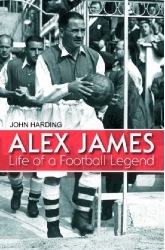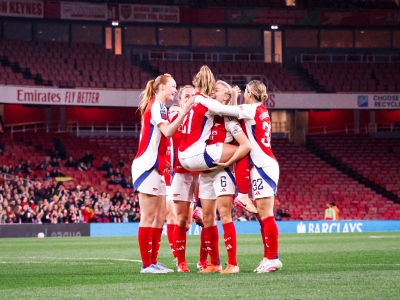To put it simply, I wrote about Alex James because I believe he was a football genius. German philosopher, Arthur Schopenhauer, puts it perfectly: “Talent hits a target no one else can hit; Genius hits a target no one else can see.” James could find the ball, the space, the target that no-one else could see. It’s the characteristic of all football geniuses: for the Gunners, Liam Brady, Dennis Bergkamp, Thierry Henry, George Eastham – they all had that ability, and there’s no point in compiling a list to rank them one, two, three. There’s no point, either, in saying that, because you didn’t see someone, you can’t judge him. You simply listen to the voices of those who could. It’s called testimony, or witness: once seen, never forgotten, and none of the many people I spoke to in the writing of the book had forgotten, some after sixty, seventy years!
I also wrote about Alex James in part as a tribute to my Dad and a favourite Uncle, both of whom were Gunners fans from boyhood and who grew up before the war, when James was still a vibrant and visible presence at Highbury. To me, as a youngster, the very name Alex James seemed to epitomise those times and that place: a grand and historic football palace, although one fallen on harder times by the time I was cutting my own teeth on the terraces, to use a painful metaphor.
When I started researching the book, in the late 1980’s, there were still old fans frequenting reserve and youth team games in the Avenell Road stand on odd Saturdays who’d actually seen James play, and I spent many a happy Saturday afternoon sitting amongst them watching the ‘stiffs’ scampering about an almost deserted stadium. The memories those fans vouchsafed were vivid and generally unanimous – there had never been and would never be another Alex James. I was also just in time to catch up with the last of those who’d played with James: Jack Crayston, George Male and Cliff Bastin, as well as Denis Compton, (who barked at me down a telephone but was kind enough to provide a foreword for the book.)
Oddly, I would discover that James had been quite close at hand when I was born – I lived a couple a streets away from the old Hendon football ground in Claremont Road, Cricklewood, where James spent some time just after the war coaching the Gunners third and fourth teams. Hendon was where the Compton brothers first played competitively, and was also the site of my first experience of regular fandom, spending my sixpence on a Saturday afternoon to watch some high-quality amateur football. Alas, like Highbury itself, the Claremont Road ground is no longer a football venue.
In fact, I chose just about the last period of time when witnesses of all kinds were still available and eager to talk. Starting up in Glasgow, I found relatives still living in Mossend, James’ home village, and in Glasgow itself a man who’d played with James in his first foray into, what is called up there, ‘Junior’ football. Over in Kirkaldy, where James played for Raith Rovers, I met another old team-mate, and down in Preston yet more characters – fans and ex-players – who were contemporaries of James when he was at North End. Dear old Tom Finney had been a youngster when he watched James, and he testified to the little man’s magical influence. In London, apart from Highbury ‘legends’, I was able to talk to both James’ children, and a friend visiting Australia interviewed James’ widow! There was even James’ old golf-pro at South Herts Golf club, Steve Thomas, to fill me in on the little man’s many recreational hours.
The book is thus not a collection of old newspaper reports: it’s full of eye-witness accounts from people who were there and who knew him, and I’m forever grateful to everyone who contributed. Revising the book this past year for a new edition afforded me the opportunity to add more voices, especially some interviewed by Jon Spurling from around the same time as I was taping older fans, and I was also able to add new pictures and cartoons of James.
The only negative feature of the whole enterprise concerns, inevitably, Arsenal F.C. itself. When the book first came out in 1988, the club showed interest and were helpful in getting it out to fans via the old store by Finsbury Park tube. Today, they refuse to touch it. The reason? They have signed a ‘sweetheart’ deal with a particular publisher (not mine) and will not handle anything that doesn’t come from them. Or to put it bluntly, they put the money before the memories - but isn’t that all too predictable? However, the book wasn’t written to make money – such books never do. It was to afford me – and you, hopefully – a glimpse into a distant but fascinating past.
My Dad used to tell a great (apocryphal?) story about going to see the first Arsenal versus Manchester United fixture at Highbury after the war. He was late and it was a lock-out. Walking back disconsolately to the tube, he heard a shout and a man gestured to him from a house in Avenell Road. He went in, was ushered upstairs and out onto the roof via a sky-light. There, lying flat on the sloping tiles, their heads peeping over the apex of the roof, were half a dozen other ex-servicemen, watching the game through that gap between the Main stand and the old North Bank. He laid on that roof (tea and biscuits at half-time) and watched the match, or what he could see of it, all through to a great 6-2 win!
That’s what writing about James was like: just clinging on in order to get a tantalising glimpse of a football world now vanished. I hope you enjoy reading it as much as I did writing it.
John Hardings book can be bought online direct from the publishers here or from Amazon here.







